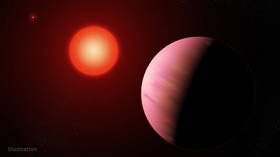Newly-discovered exoplanet twice the size of Earth could have water

Citizen scientists have discovered a potentially habitable exoplanet about twice the size of Earth, located 226 light-years away, that may have liquid water on its surface.
The new world, named K2-288Bb, was found using data from NASA’s now defunct Kepler space telescope. The spacecraft ran out of fuel in October 2018, nine years after it was launched into space to hunt for Earth-like planets.
K2-288Bb lies within its star’s habitable zone, meaning it is possible for it to hold liquid water. The planet, located in the Taurus constellation, is about half the size of Neptune and could be gas-rich or it could be rocky, according to NASA.
Adina Feinstein (@afeinstein20) announces K2-228Bb: A small temperate planet discovered by citizen scientists. #K2Mission#AAS233pic.twitter.com/h3TyUfi3uN
— Geert Barentsen (@GeertHub) January 7, 2019
Unusually, the planet is roughly 1.9 times the size of Earth – much larger than most other exoplanets that orbit close to their stars, which are normally not more than 1.5 times the size of Earth.
“It’s a very exciting discovery due to how it was found, its temperate orbit and because planets of this size seem to be relatively uncommon,” said Adina Feinstein, University of Chicago graduate student and lead author of the paper on the discovery, published by the Astronomical Journal.
All data from the Kepler mission is run through an algorithm to locate potential planets, however more manpower was needed to sift through all the possible planet ‘transits.’
Transits occur when one celestial body passes in front of a larger one, and help pinpoint other worlds. Possible planets can be spotted by studying dips in light when the planet moves before its star.
Citizen scientists stepped in and sifted through the troves of data to find K2-288Bb.
During its time, Kepler discovered more than 2,600 planets – about 50 of which are believed to be the same size and temperature as Earth. It has since been replaced by NASA’s new space telescope, the Transiting Exoplanet Survey Satellite (TESS).
Like this story? Share it with a friend!
Subscribe to RT newsletter to get stories the mainstream media won’t tell you.














